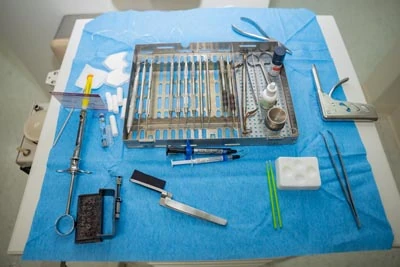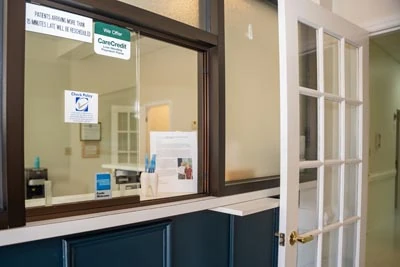Looking for a top restorative dentist in Spring Hope? At Spring Hope Family Dentistry, restorative dentistry refers to the integrated management of oral health problems to restore the complete function and aesthetic appearance of the smile. Sometimes called prosthodontics, restorative dentistry is designed to preserve the natural teeth as much as possible. Replacing missing teeth with a dental implant, bridge, full, or partial denture helps promote optimal dental health while restoring your ability to eat and bite down without tooth pain or sensitivity.
Filling in empty spaces in the mouth can help prevent cavities in the remaining teeth because odd-shaped gaps are vulnerable spots for plaque-causing bacteria to build up. Missing teeth also put extra stress on your remaining natural teeth because you don’t have as much surface area to chew with.
Revive Your Smile with Restorative Dentistry in Spring Hope

Our top dental restorations in Spring Hope, NC include:
Dental Implants
Are you missing teeth and searching for a permanent, natural-looking replacement? Dental implants may be the ideal solution. At Spring Hope Family Dentistry, we offer high-quality dental implants designed to replicate the function and appearance of your natural teeth.
Dental implants consist of a titanium post surgically placed into your jawbone. Over time, the implant integrates with your bone, forming a stable foundation for a replacement tooth. Once the implant has healed, a custom-made crown is attached to the top, creating a beautiful and functional smile.
Dental implants offer a durable, long-lasting solution for missing teeth. Their natural appearance can boost your confidence, while their improved function allows you to chew, speak, and eat comfortably. By replacing missing teeth, dental implants can significantly enhance your self-esteem and overall quality of life.
Dental Bridges
Dental bridges are a popular, budget-friendly option for replacing missing teeth. They consist of a bridge, which is a fixed dental appliance, and crowns that are cemented onto adjacent teeth.
There are several types of dental bridges:
- Traditional bridges. Traditional dental bridges are a popular and effective option for replacing missing teeth. They involve crowns placed on the teeth adjacent to the gap, connected by a bridge that fills in the missing space. This method restores the function and appearance of your smile, allowing you to eat, speak, and smile with confidence.
- Cantilever bridges. Cantilever dental bridges are a type of bridge that is supported by only one tooth on one side of the missing tooth gap. This makes them a less invasive option compared to traditional bridges, which require crowns on both sides of the gap.Cantilever bridges are often used when there is a missing tooth at the end of a dental arch..
- Maryland bridges. Maryland dental bridges, also known as resin-bonded bridges, are a less invasive alternative to traditional and cantilever bridges. They involve a metal or porcelain framework that is bonded to the back of adjacent teeth. This method preserves more tooth structure compared to traditional bridges, making it a suitable option for patients with healthy teeth.
- Implant-supported bridges. Implant-supported dental bridges are a durable and long-lasting option for replacing missing teeth. They involve dental implants that are surgically placed into the jawbone, providing a stable foundation for the bridge. This type of bridge offers a more natural appearance and better function compared to traditional, cantilever, or Maryland bridges.
Dental bridges offer numerous benefits. They can restore the appearance of your smile by filling in gaps caused by missing teeth, improving your overall aesthetics. Dental bridges can also enhance your ability to chew and speak more comfortably.
To determine which type of bridge is right for you, consult with your provider at Spring Hope Family Dentistry. They will evaluate your oral health and discuss your options to find the best solution for your specific needs.
Implant-Supported Dentures
Implant-supported dentures are a type of denture that is anchored to dental implants placed into the jawbone. This provides a more secure and stable fit compared to traditional dentures, which can slip or shift. Implant-supported dentures offer several benefits, including improved comfort, chewing ability, and speech clarity. They also eliminate the need for denture adhesives and can help preserve jawbone density.
Overdentures
Overdentures are removable dentures that are supported by natural teeth or dental implants. They offer a more stable fit and improved comfort compared to traditional dentures. Overdentures can be supported by two or more natural teeth, or by dental implants, which provide a more secure and durable foundation. This option is suitable for patients who have a few remaining natural teeth or who prefer a removable denture solution.
Hybrid Dentures
Hybrid dentures, also known as fixed-removable dentures or implant-retained overdentures, are a combination of fixed and removable components. They typically involve a fixed framework of dental implants that is attached to a removable denture base. This design offers a more secure fit and improved stability compared to traditional dentures, while still allowing for easier cleaning and maintenance. Hybrid dentures are a popular choice for patients who desire a combination of fixed and removable denture options.
Removable Dentures
Removable dentures are a popular option for replacing missing teeth. They are custom-made prosthetics that can be removed and inserted into the mouth. Removable dentures can be supported by natural teeth or by the underlying bone and soft tissues. They are a cost-effective option for replacing multiple teeth, but may require more maintenance and adjustments compared to fixed dental restorations.
At Spring Hope Family Dentistry, we offer different options of removable dentures to fit your specific needs, including immediate removable dentures that are inserted into the mouth immediately after the extraction of teeth, custom-crafted partial dentures used to replace a portion of your teeth, and complete removable dentures are used to replace all of your teeth in a single arch.
Complete dentures can help restore your smile, improve your chewing function, and prevent your jawbone from deteriorating. However, they may require more maintenance and adjustments compared to fixed dental restorations. To learn more about the various removable denture options available and find the best solution for your needs, schedule your consultation with Dr. Elie Abboud at Spring Hope Family Dentistry.
Dental Crowns

- All Porcelain. All-porcelain dental crowns offer a highly aesthetic and biocompatible option for restoring damaged or missing teeth. Made entirely from porcelain, these crowns closely mimic the translucency and natural appearance of real teeth. All-porcelain crowns are often preferred by patients who have allergies to metal or who desire a completely metal-free restoration. They are also a popular choice for patients in the front of the mouth where aesthetics are a top priority.
- Zirconia. Zirconia dental crowns are a durable and aesthetically pleasing option for restoring damaged or missing teeth. Made from a strong and biocompatible ceramic material, zirconia crowns offer excellent strength and resistance to wear and tear. They also have a natural appearance that closely mimics the translucency and color of real teeth. Zirconia crowns are a popular choice for both anterior and posterior teeth, and they are often preferred by patients who desire a metal-free restoration.
Want to know more about our dental crown options available and find the perfect one for your needs? Contact Dr. Elie Abboud at Spring Hope Family Dentistry. Our office is dedicated to providing personalized care and helping you achieve a healthy, beautiful smile. Give us a call today to schedule your appointment!
Learn More at Your Restorative Dentistry Consult
At Spring Hope Family Dentistry, we're committed to providing personalized, state-of-the-art dental care for your entire family. Our experienced team is dedicated to helping you achieve and maintain optimal oral health by covering your complete restorative dental needs. Contact us today to discuss your needs for restoring your smile!